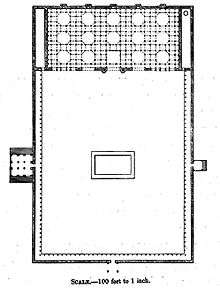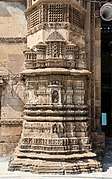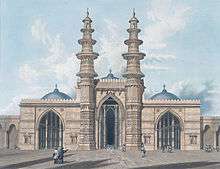Jama Mosque, Ahmedabad
Jama Masjid (literally Friday Mosque), also known as Jumah Mosque, is a mosque in Ahmedabad, India built in 1424 during the reign of Ahmad Shah I. Lying in the old walled city, the mosque is situated outside Bhadra Fort area, along the south side of the road extending from Teen Darwaza to Manek Chowk.
| Jama (Jami) Masjid | |
|---|---|
 Jama (Jami) Masjid, Ahmedabad | |
| Religion | |
| Affiliation | Islam |
| Status | Active |
| Location | |
| Location | Ahmedabad |
| Municipality | Ahmedabad Municipal Corporation |
| State | Gujarat |
 Location of Jama mosque in Gujarat, India | |
| Geographic coordinates | 23.023822°N 72.587222°E |
| Architecture | |
| Type | Mosque |
| Style | Indo-Islamic architecture |
| Founder | Ahmed Shah I |
| Completed | 1424 |
| Specifications | |
| Dome(s) | 15 |
| Spire(s) | 260 |
| Materials | Yellow sandstone |
| Designated as NHL | National Monument of Importance ASI Monument No. N-GJ-7 |
Location
The Jama Masjid of Ahmedabad was probably the largest mosque in the Indian subcontinent built in this period. Designed as part of a major plan desired by Sultan Ahmed Shah, the mosque is located south of the processional axis that runs from the Maidan-i Shah at the door with three arches, Teen Darwaza.
To the west of the mosque are the tombs of Ahmed Shah I, his son and his grandson, Ahmed Shah's Tomb. Nearby are the graves of the queens and the other wives of the king, Rani no Hajiro.
Architecture


Built with yellow sandstone, the mosque complex is centered on a large rectangular courtyard 75 m long and 66 m wide. One enters the court by three entrances, one at the center of each side. The courtyard is lined with a colonnade on three sides, the prayer hall occupies the fourth (east) side. In the center of the courtyard is a rectangular basin for ablutions.
The prayer room is also rectangular and covered by four domes. In its Indo-Saracenic architecture, the mosque also contains many syncretic elements not necessarily obvious to the viewer: some of the central domes are carved like lotus flowers, closely related to the typical domes of Jain temples; and some of the pillars are carved with the form of a bell hanging on a chain, in reference to the bells that often hang in Hindu temples. The wide-open courtyard, floored with white marble, is ringed by a colonnade painted with giant Arabic calligraphy, and has a tank for ritual ablutions in the center. The mosque and arcades are built of beautiful yellow sandstone and carved with the intricate detail that mosques of this period are known for. While the two principal minarets flanking the main arched entranceway collapsed in the 1819 earthquake, their lower portions still stand. The main prayer hall has over 260 columns supporting the roof, with its 15 domes, making a walk through the hall a beautiful maze of light and shadows. The Wall of Prayer, the qibla is decorated. Pierced stone screens (the 'Jalis') are placed between the two pillars of the central openings. The main entrance is framed by two columns, the remains of two minarets (the 'shaking minarets') which were destroyed by the earthquakes of 1819 and 1957.

 The prayer room
The prayer room Detail of a minaret
Detail of a minaret A mihrab in the mosque
A mihrab in the mosque- Pillars in periphery of Jama Masjid
 The basin for ablutions
The basin for ablutions Water Fountain
Water Fountain
History

The inscription on the mihrab commemorates the inauguration of the mosque on 4 January 1424 by Sultan Ahmad Shah I. The mosque was originally intended only for private use of the sultans.
References
- Official Website
- Davies, Philip. 1989. The Penguin Guide to the Monuments of India. London: Penguin books, II, 338-340.
- Michell, George, Snehal Shah. (eds.) 1988. Ahmadabad. Mumbai: Marg Publications, 32-33, 42-43.
| Wikimedia Commons has media related to Jama Masjid (Ahmedabad). |